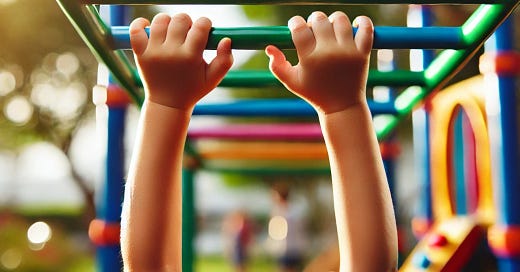The Monkey Bar Test: Rethinking Risk and Resilience in Childhood
This post explores the impact of overprotective parenting and risk-averse attitudes, drawing parallels between childhood play and the broader trend of "safety capitalism".
The Monkey Bar Test
The playground at my children's school has a "monkey bar test." To use the monkey bars, you must prove you can successfully cross from one side of the monkey bars to the other. I’m glad I didn't face the unnecessary pressure of passing a test when I learned to use the monkey bars in the early 90’s!
Many older millennials, Gen Xers, and older generations fondly remember walking to school, wandering the neighborhood, and flying off the metal merry-go-round. My mom was part of a fence-hopping club in the 60s. In some ways, it's surprising that my kids’ school even has monkey bars since they've disappeared from many parks. Sometimes educators come up with these safety-oriented, risk-averse rules, and sometimes parents lobby for them.
Safety Parenting
Parents and educators intend to protect kids from the modern world's dangers. These behaviors tether kids to parents more closely and give them less experience dealing with others, contributing to the "delayed adulthood" syndrome most prominent in Gen Zs. Some aspects of this syndrome, such as fewer teen drivers, fewer teen workers, and more prolonged financial dependence on parents, have been documented by researchers such as Jean Twenge. Other aspects, such as heightened anxiety, outrage culture, and seeing “life as a battle between good people and evil people,” come from what Jonathan Haidt and Greg Lukianoff call “paranoid parenting.”
Educators and parents aren't always on the same page. A current flashpoint is about the use of phones in schools. Some parents at my local high school have protested phone-free school proposals. They want to be able to contact their children in case of an emergency, like the threat of a school shooting. Parents believe that if there is a live shooter in their children's school, it would be risky if students did not have cell phones.
Risk Intolerance
In our data, Gen Zs demonstrate lower comfort with risk and ambiguity, less self-efficacy, and lower locus of control than older millennials. This may be related to age and experience. It also may be related to upbringing. Gen Zs who identify as more ideologically liberal also tend to demonstrate lower comfort with risk and ambiguity, less self-efficacy, and lower locus of control than moderates and conservatives.
It is increasingly clear that the downside of safety parenting is young people who don’t experience situations where they have incomplete information and are still required to evaluate possible outcomes and decide what to do.
Measuring Risk
I encourage the use of two thought processes when evaluating risk; in this schema, severity measures harm to a person’s well-being, so in the example below, being paralyzed and feeling less safe about life are negatives with varying levels of severity.
Likelihood: Let's say, on a scale from one to ten, the severity of falling from a monkey bar and becoming paralyzed is a ten (high), and the likelihood of this happening is one (low). Monkey bars risk is ten.
Opportunity Cost: Not allowing kids to try monkey bars means they are losing out on learning to overcome challenges. (See the excellent work of Lenore Skenazy and Let Grow for more on this!). Let's say that kids who are told the monkey bars are dangerous now feel less safe trying new things. The severity of a child feeling unsafe to try new things might be a three, and the likelihood of this occurring is a five (about half will feel less safe). Monkey bar opportunity cost is fifteen.
In this calculation, opportunity costs outweigh risk so I’d let my kids go wild on the monkey bars. Similar back-of-the-napkin calculations are now proven by science!
Anthropologists at Dartmouth just published a study on early humans, kids, and monkey bars and found that swinging, climbing, jumping, and other “risky play” is elemental for human development. Monkey bars allow kids to “engage in play where there is some level of risk so they can overcome challenges on their own and learn from it when it doesn’t work out.” And this risk of physical injury? The researchers calculate it’s 6 in 1,000,000, far less than injuries from organized sports.
Safety in Other Domains
In her recent Fast Company piece about “Safety Capitalism”, Christina wrote that most young Americans support capitalism in terms of its focus on private ownership, competition, and the right to decide how to use one’s wealth but are bearish when it comes to risk and failure. She quoted Charlie Munger stating “Capitalism without failure is like religion without hell.” We’d make the same analogy about childhood and risk!
A positive point is that, despite the fact that many Millennial parents are overly focused on what they believe to be safe parenting, they show more tolerance of risk in other domains. For example, among those with kids, 68% believe that “We are all made better by the trials and hardships of life” vs. 54% of those without kids. Similarly, parents are more likely than non-parents to agree that “Most people are trustworthy” and that “I usually view risks as a challenge.”
So perhaps even though safety parenting poses a potential problem for the Generation Alpha children of Millennials and Gen Z, at least the experience of raising children provides a bit more context to how risk is evaluated!



